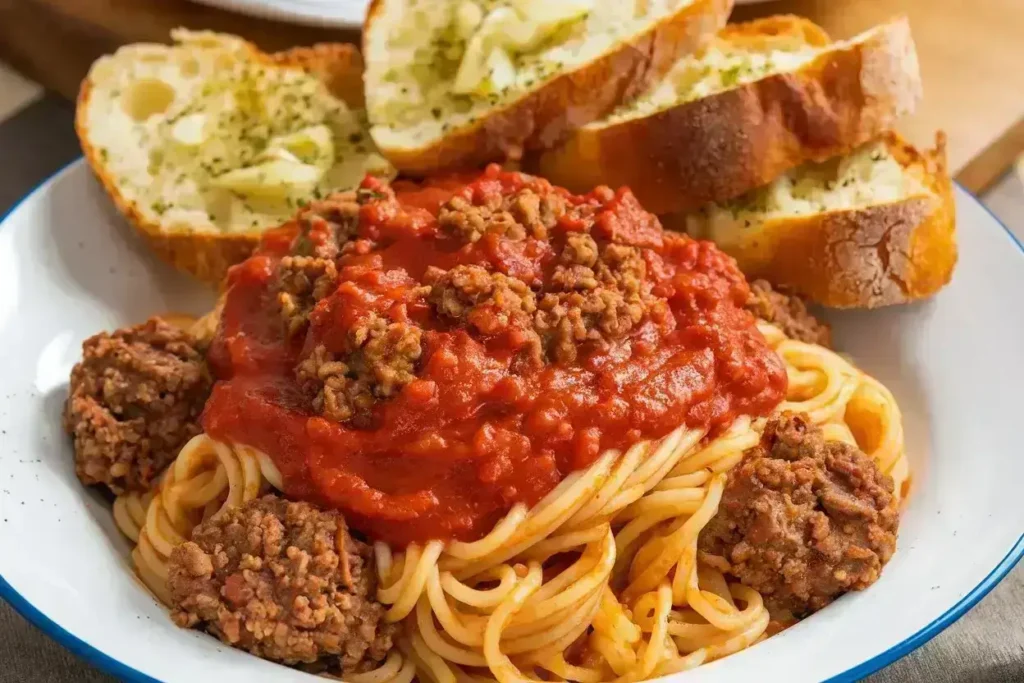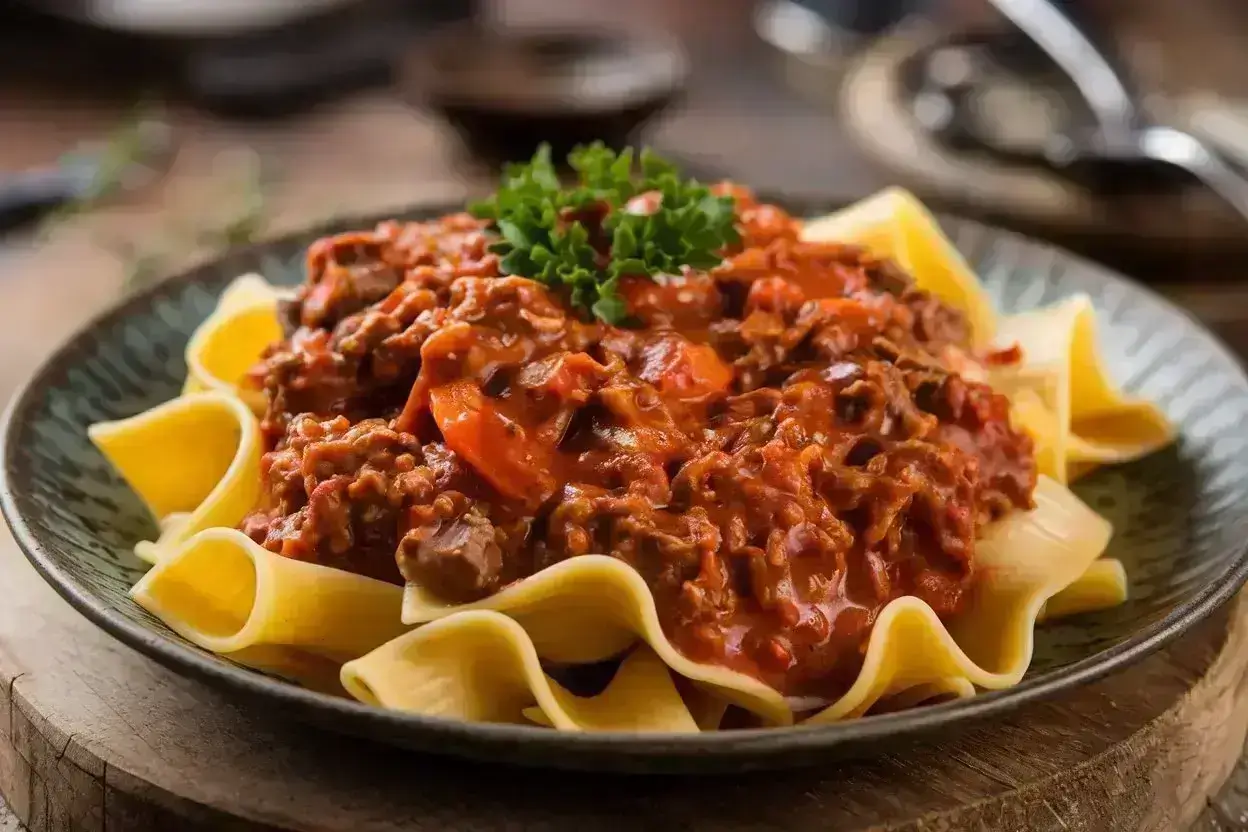Table of contents
- Introduction to Beef Cuts for Pasta
- Why Does the Cut of Beef Matter for Pasta?
- Best Beef Cuts for Classic Pasta Dishes
- Specialty Cuts for Gourmet Pasta
- How to Choose the Right Cut of Beef
- Common Mistakes When Selecting Beef for Pasta
- Preparing Beef for Pasta Dishes
- Nutritional Information of Beef Cuts in Pasta Dishes
- Advanced Tips for Perfecting Beef and Pasta Dishes
- Frequently Asked Questions
Introduction to Beef Cuts for Pasta
When deciding on the best cut of beef for pasta, it’s essential to consider texture, flavor, and tenderness. The right beef cut not only enhances your pasta dish but also complements the sauce, creating a truly balanced meal.
Why Does the Cut of Beef Matter for Pasta?
The best cut of beef for pasta depends on how you plan to cook it. Cuts like chuck and short ribs are perfect for slow-cooked sauces, while sirloin and ground beef are versatile for quicker recipes.
Texture and Tenderness: Key Factors
Beef texture plays a major role in how it interacts with pasta. Tender cuts like sirloin can be quickly cooked for a silky bite, while tougher cuts like chuck shine in slow-cooked sauces, breaking down into melt-in-your-mouth goodness.
Flavor Profiles and Pairing with Sauces
Different cuts offer unique flavors. Cuts with more marbling (fat content) like short ribs add a deep, savory richness that pairs well with hearty tomato sauces. Leaner cuts, on the other hand, work beautifully in lighter cream-based or olive oil sauces.
Best Beef Cuts for Classic Pasta Dishes
Some cuts have earned their place as staples in pasta recipes. Let’s explore which ones shine brightest in the classics:
Beef Chuck: A Versatile Favorite
Beef chuck is a star in slow-cooked pasta dishes like ragu or stew-based sauces. Its high fat content ensures moist, tender meat after hours of simmering. Plus, its bold flavor complements robust ingredients like garlic, onions, and red wine.
Short Ribs: Perfect for Slow-Cooked Sauces
Short ribs are the royalty of rich, hearty pasta sauces. Braising these cuts until they fall off the bone creates a luxurious texture and infuses the sauce with deep, beefy flavors. Pair with pappardelle or tagliatelle for a restaurant-worthy dish.
Ground Beef: The Staple for Everyday Pasta
When you think of classic spaghetti Bolognese or lasagna, ground beef probably comes to mind. It’s economical, easy to work with, and absorbs flavors from your seasonings and sauces like a pro. For best results, use ground beef with a fat content of around 20%.
Specialty Cuts for Gourmet Pasta
Want to elevate your pasta game? Specialty cuts are your ticket to a next-level dining experience.
Beef Brisket: A Unique Choice
Although brisket is better known for BBQ, it’s a surprisingly fantastic option for pasta. When slow-cooked, it becomes incredibly tender and brings a smoky, robust flavor that adds intrigue to dishes like ragu.
Sirloin: Balancing Flavor and Tenderness
For those who prefer a quicker cooking process, sirloin offers a fine balance of tenderness and flavor. Slice it thinly and pair with simple ingredients like olive oil, garlic, and herbs for an elegant pasta dish.
How to Choose the Right Cut of Beef
Selecting the perfect beef cut can feel overwhelming, but a little knowledge goes a long way. Here are some tips to make the decision easier:
Consider Cooking Methods
Are you making a quick sautéed dish or a slow-simmered sauce? Tender cuts like sirloin or ribeye are perfect for quick cooking, while tougher cuts like chuck or shank are ideal for slow-cooked recipes.
Matching Beef Cuts with Pasta Types
The type of pasta you’re using should guide your beef selection. Thin, delicate pastas like angel hair pair well with lighter beef cuts, while hearty shapes like rigatoni or pappardelle need bold, robust meats like short ribs or chuck.
Budget-Friendly Options Without Sacrificing Quality
Cooking on a budget? Ground beef or stew meat are affordable yet flavorful choices. They’re easy to prepare and work well in a variety of pasta dishes without breaking the bank.
Common Mistakes When Selecting Beef for Pasta
Even the most seasoned cooks make missteps when choosing beef for pasta. Here are a few pitfalls to avoid:
Overlooking Fat Content
Fat is flavor! Selecting beef that’s too lean can result in a dry, bland dish. Opt for cuts with marbling for a juicier, tastier result.
Using Pre-Cut or Pre-Packaged Meat
While convenient, pre-packaged meat often lacks freshness and flavor. Whenever possible, choose whole cuts and prepare them yourself for better quality.
Preparing Beef for Pasta Dishes
Once you’ve chosen the right cut, preparation is key to bringing out its best qualities.
Proper Slicing Techniques
How you slice your beef can affect the final texture of your dish. Always cut against the grain for tender, bite-sized pieces that blend seamlessly with your pasta.
Marinating and Seasoning Tips
Marinating beef before cooking can elevate its flavor profile. Use simple marinades with olive oil, herbs, and a splash of vinegar or wine to complement the dish’s overall taste.
Nutritional Information of Beef Cuts in Pasta Dishes
Why Nutritional Value Matters
When incorporating beef into pasta dishes, it’s helpful to understand the nutritional benefits each cut offers. Beef is a powerhouse of essential nutrients like protein, iron, and B vitamins, all of which contribute to a balanced meal. However, not all cuts are created equal when it comes to fat and calorie content, so choosing wisely can help you meet your dietary goals.
Nutritional Comparison of Popular Cuts
The following table provides a breakdown of the nutritional content of common beef cuts used in pasta dishes (per 3-ounce serving):
| Cut of Beef | Calories | Protein (g) | Fat (g) | Saturated Fat (g) |
|---|---|---|---|---|
| Ground Beef (80/20) | 216 | 22 | 14 | 5.6 |
| Beef Chuck (Braised) | 230 | 24 | 15 | 6.0 |
| Short Ribs (Braised) | 250 | 23 | 18 | 7.2 |
| Sirloin (Grilled) | 150 | 26 | 5 | 2.0 |
| Beef Brisket (Smoked) | 300 | 21 | 22 | 8.0 |
Key Takeaway: For leaner options, sirloin stands out, while short ribs and brisket are higher in fat but offer exceptional flavor for indulgent recipes.
Health Benefits of Including Beef in Pasta
- Protein Powerhouse: Beef is an excellent source of high-quality protein, essential for muscle growth and repair.
- Iron-Rich Goodness: Cuts like chuck and brisket are rich in heme iron, which is easily absorbed by the body and supports energy levels.
- Vitamin Boost: Beef contains significant amounts of B12, which is crucial for maintaining healthy nerve function and red blood cell production.
Balancing Beef and Pasta for a Healthy Meal
To keep your dish nutritious without compromising flavor, consider these tips:
- Pair beef with whole-grain pasta to boost fiber intake.
- Add a variety of vegetables like spinach, mushrooms, or zucchini for added vitamins and minerals.
- Use moderate portions of beef and complement it with lighter sauces or broths to balance the richness.
Popular Recipes Featuring Beef and Pasta

Sometimes, the best inspiration comes from classic recipes. Here are a few beloved dishes that showcase the perfect marriage of beef and pasta:
Spaghetti Bolognese
This timeless dish combines ground beef with tomatoes, onions, garlic, and Italian herbs to create a flavorful sauce that clings beautifully to spaghetti.
Ingredients:
- 1 lb ground beef (80/20)
- 1 onion, diced
- 3 cloves garlic, minced
- 1 can (28 oz) crushed tomatoes
- 2 tbsp olive oil
- 1 tsp dried oregano
- 1 tsp dried basil
- Salt and pepper to taste
Nutrition Facts (Per Serving):
| Calories | Protein (g) | Fat (g) | Carbs (g) |
|---|---|---|---|
| 450 | 25 | 12 | 50 |
Beef Ragu with Pappardelle
A hearty ragu made with slow-cooked beef chuck or short ribs is the epitome of comfort food. Its rich, savory sauce clings to wide ribbons of pappardelle, making every bite irresistible.
Ingredients:
- 2 lbs beef chuck or short ribs
- 1 onion, finely chopped
- 2 carrots, diced
- 2 celery stalks, diced
- 1 cup red wine
- 1 can (28 oz) crushed tomatoes
- 1 sprig fresh rosemary
- Salt and pepper to taste
Creamy Beef Stroganoff Pasta
If you’re craving a creamy, indulgent pasta, beef stroganoff delivers. Made with thinly sliced sirloin, mushrooms, and a sour cream-based sauce, it’s both luxurious and satisfying.
Ingredients:
- 1 lb sirloin steak, thinly sliced
- 1 cup mushrooms, sliced
- 1 cup sour cream
- 1 tbsp Dijon mustard
- 1 tbsp flour
- Salt and pepper to taste
Quick Tip: Serve with egg noodles or penne for the best texture match.
Tips for Cooking Beef Perfectly for Pasta
Cooking beef properly ensures your dish is flavorful and the meat is tender. Here’s how to do it right:
Sear Before Slow Cooking
For cuts like chuck or short ribs, searing the meat before slow cooking locks in flavor and creates a beautiful caramelized crust.
Don’t Overcrowd the Pan
When browning ground beef or searing steaks, avoid overcrowding the pan. This ensures proper browning instead of steaming the meat.
Rest Before Slicing
Always let cooked beef rest for a few minutes before slicing to allow the juices to redistribute, ensuring every bite is juicy and flavorful.
Advanced Tips for Perfecting Beef and Pasta Dishes
Unlocking the Secret to Perfect Beef Texture
Perfect beef texture in pasta dishes starts with choosing the right cut, but the cooking process is where the magic happens. Here are some advanced tips to help you elevate your dishes to restaurant-quality levels:
1. Use the Sous Vide Method for Precision Cooking
If you want tender beef every time, sous vide is a game-changer. This technique involves vacuum-sealing beef and cooking it in a water bath at a precise temperature. For cuts like chuck or short ribs, sous vide ensures even cooking and keeps the meat moist.
- Recommended Temperature: 135°F (medium-rare) for tender cuts, 155°F for braised textures.
- Time: 24–48 hours for tough cuts; 1–2 hours for tender ones.
2. Deglaze the Pan for Flavorful Sauces
After searing beef, deglaze the pan with wine, broth, or a splash of balsamic vinegar. This technique lifts the caramelized bits (fond) from the pan, creating a deeply flavorful base for your pasta sauce.
3. Layer Flavors for Depth
Create complex flavors by layering ingredients. For example:
- Sauté onions and garlic in olive oil.
- Add tomato paste and cook until caramelized.
- Introduce beef and spices like smoked paprika or thyme before adding liquids like wine or broth.
Pairing Beef with Homemade Sauces
Crafting the right sauce is just as important as selecting the beef. Here are some pairings that will make your pasta unforgettable:
1. Marinara Meets Ground Beef
Ground beef adds a hearty texture to marinara sauce. Start with a base of crushed tomatoes, garlic, and olive oil, then stir in browned beef for a quick and satisfying meal.
2. Rich Red Wine Reduction for Braised Beef
Short ribs or chuck benefit from sauces made with red wine reductions. Cook down red wine with rosemary, thyme, and garlic, then combine with a tomato base for a luxurious ragu.
3. Creamy Mushroom Sauce for Sirloin
Thinly sliced sirloin pairs beautifully with a cream sauce made of mushrooms, white wine, and heavy cream. Toss with fettuccine for a velvety dish.
Plating and Presentation Tips
We eat with our eyes first, so presentation matters! Follow these plating tips to make your pasta dishes visually stunning:
- Twirl the Pasta: Use tongs to create a neat pile of pasta in the center of the plate.
- Top with Beef Strategically: Place chunks or slices of beef on top of the pasta for an elegant look.
- Finish with Garnishes: Add fresh herbs, grated cheese, or a drizzle of olive oil to enhance both the flavor and presentation.
Creative Pasta and Beef Combinations to Try
If you’re ready to think beyond the classics, here are some innovative combinations to inspire your next dish:
1. Korean-Inspired Bulgogi Pasta
Combine thinly sliced ribeye, soy sauce, sesame oil, and garlic with udon noodles for a fusion dish packed with umami.
2. Beef and Pesto Penne
Sear sirloin tips and toss with penne, homemade basil pesto, and roasted cherry tomatoes. This dish is fresh, vibrant, and perfect for summer.
3. Moroccan Spiced Beef Tagine with Couscous Pasta
Use beef shank or stew meat spiced with cinnamon, cumin, and paprika, and serve over Israeli couscous for a Middle Eastern twist.
How to Pair Wine with Beef and Pasta
Pairing the right wine can elevate the dining experience. Here are a few tips:
- For Tomato-Based Sauces: Choose medium-bodied reds like Chianti or Sangiovese.
- For Cream-Based Sauces: Opt for white wines like Chardonnay or Pinot Grigio.
- For Hearty Ragus: Full-bodied reds like Cabernet Sauvignon or Barolo are excellent.
Sustainability Tips for Choosing Beef
For those who care about sustainability, here are some ways to make eco-friendly choices:
- Opt for Grass-Fed Beef: Grass-fed beef is often more sustainable and has a richer flavor.
- Support Local Farmers: Buying from local farms reduces the environmental footprint.
- Use Every Part: Minimize waste by using bones for broths and trimmings for stock.
Frequently Asked Questions
Can I Use Stew Meat for Pasta?
Yes, stew meat can be a great option for slow-cooked pasta dishes like beef ragu or hearty tomato-based sauces. However, it’s important to allow plenty of time for it to cook and become tender. Stew meat typically comes from tougher cuts like chuck or round, which benefit from low and slow cooking to break down the connective tissue.
How Do I Store Leftover Beef for Pasta Dishes?
Leftovers can be a lifesaver for quick meals! Here’s how to store them properly:
- Refrigeration: Place leftovers in an airtight container and refrigerate within two hours of cooking. Consume within 3–4 days.
- Freezing: Beef-based sauces freeze beautifully. Store in freezer-safe containers for up to three months.
- Reheating: Reheat slowly on the stove or in the microwave, adding a splash of water or broth to maintain moisture.
Conclusion
Pairing the right cut of beef with your pasta can elevate a simple dish into a culinary masterpiece. From the rich, marbled flavors of short ribs to the budget-friendly versatility of ground beef, every cut has its place in the kitchen. Whether you’re cooking for a family dinner or impressing guests, understanding how to select, prepare, and cook beef for pasta ensures a delicious and satisfying result every time.

